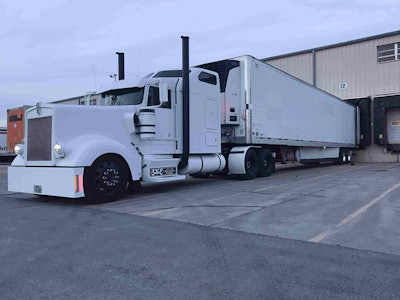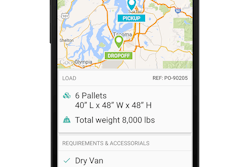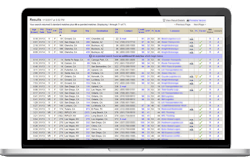 Independent Chad Boblett says checking a broker’s reviews helps him determine if apparent problems are deal-breakers or things he can work around.
Independent Chad Boblett says checking a broker’s reviews helps him determine if apparent problems are deal-breakers or things he can work around.Not only has the internet and mobile technology made finding loads quicker and easier than ever, those same resources also can provide more in-depth and current information on broker performance.
Most load services require a subscription, ranging from around $35 to $150 per month.
Load board leaders DAT and Truckstop.com track their customers’ experience, so they can provide detailed statistics on how those loads worked out, such as brokers’ average days to pay and more. The DAT Load Board and Truckstop Mobile apps are customized to make viewing broker and load information easy on mobile devices.
DAT’s TruckersEdge (www.truckersedge.net) load board has a free package, but it only allows drivers to post their trucks – they cannot view broker information or access other features. DAT’s TruckersEdge Enhanced ($49.95 per month) and DAT Pro ($99 per month) include access to broker credit information. Truckstop.com has packages at $35, $125 and $150, but only the top two tiers include access to broker information.
Certain services not affiliated with load boards, such as RTS Credit Service, also provide credit reports on brokers that include days to pay, broker authority, bond information and more.
Then there are more specialized sources. For example, Red Book Credit Services and Blue Book Services provide transportation-related credit rating information for the fresh produce industry.
The National Association of Small Trucking Companies’ Best Broker program is made up of what the association considers to be the top 5 percent of brokers, based on payment history and member recommendations. Carriers must be NASTC members to have access to the Best Broker list.
The Transportation Intermediaries Association, a group representing brokers, also has a quality designation. Use of the TIA Member logo indicates the brokerage meets membership criteria, which includes having no unexplained nonpayment complaints; using written contracts and written rate confirmations; having insurance; having a written carrier selection criteria; having no TIA Watchdog reports filed against them; and having a minimum credit score of 80, maximum days to pay of 30 or three credit references.
Brokers are not required by law to carry insurance, but TIA suggests its members carry four types: general liability, contingent cargo, contingent auto, and errors and omissions.
 Mark Fields, owner of JVF Transport, runs this 1998 Kenworth W900. He places a lot of weight on a broker’s average days to pay and longevity in the business.
Mark Fields, owner of JVF Transport, runs this 1998 Kenworth W900. He places a lot of weight on a broker’s average days to pay and longevity in the business.Anyone using a TIA member broker has some recourse if there is a nonpayment issue, says Nancy O’Liddy, TIA vice president of government affairs. If TIA’s six-member ethics commission reviews a complaint against a member and finds the broker was in the wrong, the broker is given a chance to pay or lose membership.
TIA also offers a more advanced designation, the Certified Transportation Broker logo, that signifies that the broker has passed an intensive course and exam.
It’s essential to do research before taking a load from an unfamiliar broker, says Mark Fields, driver and owner of 12-truck fleet JVF Transport. “For guys with one or two trucks, one loss is huge,” Fields says. “It can shut you down.”
Fields, who uses Truckstop.com and DAT to find freight for his fleet, tends to pay attention to a broker’s days to pay and MC number before taking a load. He says if the MC number is high, meaning it’s a newer brokerage, he either stays away from it or asks for half down before the delivery.
“New brokers that open – some are legit, and some are scams,” he says. “I have a brokerage along with my company, and I had to go through the same thing when we started out.”
To help ease such concerns, DAT for years has hosted a Google- or Amazon-style review system. Carriers and brokers can rate one another on a five-star system and write a review.
“Drivers are already talking about brokers – who’s been good and who hasn’t – and this is just an extension of that conversation,” says Kevin Scullin, DAT product manager. “Brokers have metrics on drivers, so this is a way to bring that to the surface so everybody can benefit.”
O’Liddy says an owner-operator can take steps to look more attractive to brokers looking for trucks: Make sure relevant information is up-to-date and active with the Federal Motor Carrier Safety Administration, and stay with the same insurance company rather than jumping around.
O’Liddy says the same principle can be applied when examining a broker. She suggests checking that the phone number and other information matches what’s on file with FMCSA. Also, if a broker’s bond has been replaced often, there could be a problem.
“These are easy signs to look for, and they’re right there on FMCSA’s site,” she says.
DAT’s review system, as well as open review systems, “are starting to take the place of the credit score,” says independent Chad Boblett, owner of Boblett Brothers. “Brokers know … they will be held accountable if they don’t pay the drivers, and this system also gives the brokers a chance to respond to a driver’s negative experience with them.” Boblett is also founder of Rate Per Mile Masters, a Facebook group he started three or four years ago for owner-operators to talk about rates, lanes and business strategy.
Scullin says DAT’s review system gets all the facts of a situation out on the table. “Can I see if a bad review was a heat-of-the-moment response, or is something fundamentally wrong with how a certain broker conducts business?” he asks. “The reviews help carriers determine if something just went wrong or if there is a pattern.”
Boblett says reviews have saved him more than once from a bad load. He once read that the broker had not paid a driver for sitting at the shipper for six hours on the same load Boblett was considering.
“I had almost finalized the load, but I immediately called [the broker] back to ask about detention,” Boblett says. “For me, if you don’t pay detention, I’m out. My time isn’t free. If I see several reviews that say ‘did not pay detention,’ I make sure to call the broker to ask about it.”
In Truckstop.com’s load board, owner-operators can see brokers graded on an A-to-F scale, along with average days to pay and more. Nate Rowlan, training manager for Truckstop.com, says the grading and information provided to drivers comes from driver feedback and factoring companies. As for concerns about new brokerages, Truckstop.com rates them “N” until they have been in business for a year.
“Every 90 days, brokers come up in a queue for us to do a manual review,” Rowlan says. “A lot of payment information comes in almost daily.”
In cases where there isn’t enough information for the review, Truckstop.com will call on carriers that have hauled freight recently for the brokers. Also, if brokers have five unresolved disputes or $10,000 worth of complaints from carriers, they are removed from Truckstop.com’s load board until they resolve the complaints, Rowlan says.
Merrill Heim, independent and owner of seven-truck fleet Alumni Logistics, uses Truckstop.com’s grading system to help determine which brokers to contact.
“If I see a broker has a low score, I tell them it has to be cash on delivery, or I won’t haul it,” Heim says. “I tend to look for brokers that pay within 15 days or less and have a better reputation. Usually, when you call a broker, you can tell if they’re trying to take advantage of you. They’ll start to play a numbers game with you.”
Rating is a two-way street
As the old adage goes: “What’s good for the goose is good for the gander.” Just as carriers can review and rate brokers within DAT’s and Truckstop.com’s load boards, so too can brokers rate carriers on their experiences.
In DAT’s system, brokers can see safety information on carriers. The more good feedback a carrier gets from brokers, the better the carrier looks to other brokers, which could help in getting better loads, says Boblett.
“The biggest thanks a broker can do that will make me remember a good experience with them is when they write a review on me,” Boblett says. “As owner-operators, we’re entrepreneurs, and positive feedback is huge for us and our businesses.”
Boblett says brokers often don’t review carriers. DAT suggests if drivers want to get more of them, just ask the brokers. “It’s easy for them to do, so it doesn’t hurt to ask,” Scullin says.
For Truckstop.com, Rowlan says the goal is to help both sides make good business decisions, so he encourages carriers and brokers to leave feedback, good and bad.
Investing in relationships pays off
One of the best preparations for a downturn is having good broker relationships.
“I tell my drivers that the brokers are my customers,” Heim says. “Even though it’s brokered freight, it’s repeat business, and it becomes a relationship.”
The principle is easy to ignore in good times, Boblett says.
“Up through 2014, it really didn’t matter who you were – you could get $3 a mile,” he says. “But in the middle of 2015-2016, if you didn’t have a relationship [with brokers], you weren’t making money and were doing a lot of sitting.”
Boblett sometimes gets a call about a load before it ever gets posted because of his longstanding broker relationship.
“At the same time, if I need a load, I can call one of these brokers and see if I can get the same load I’ve had before,” he says. “I’ve been getting more freight from brokers, so that’s how I’ll continue to do things.”











